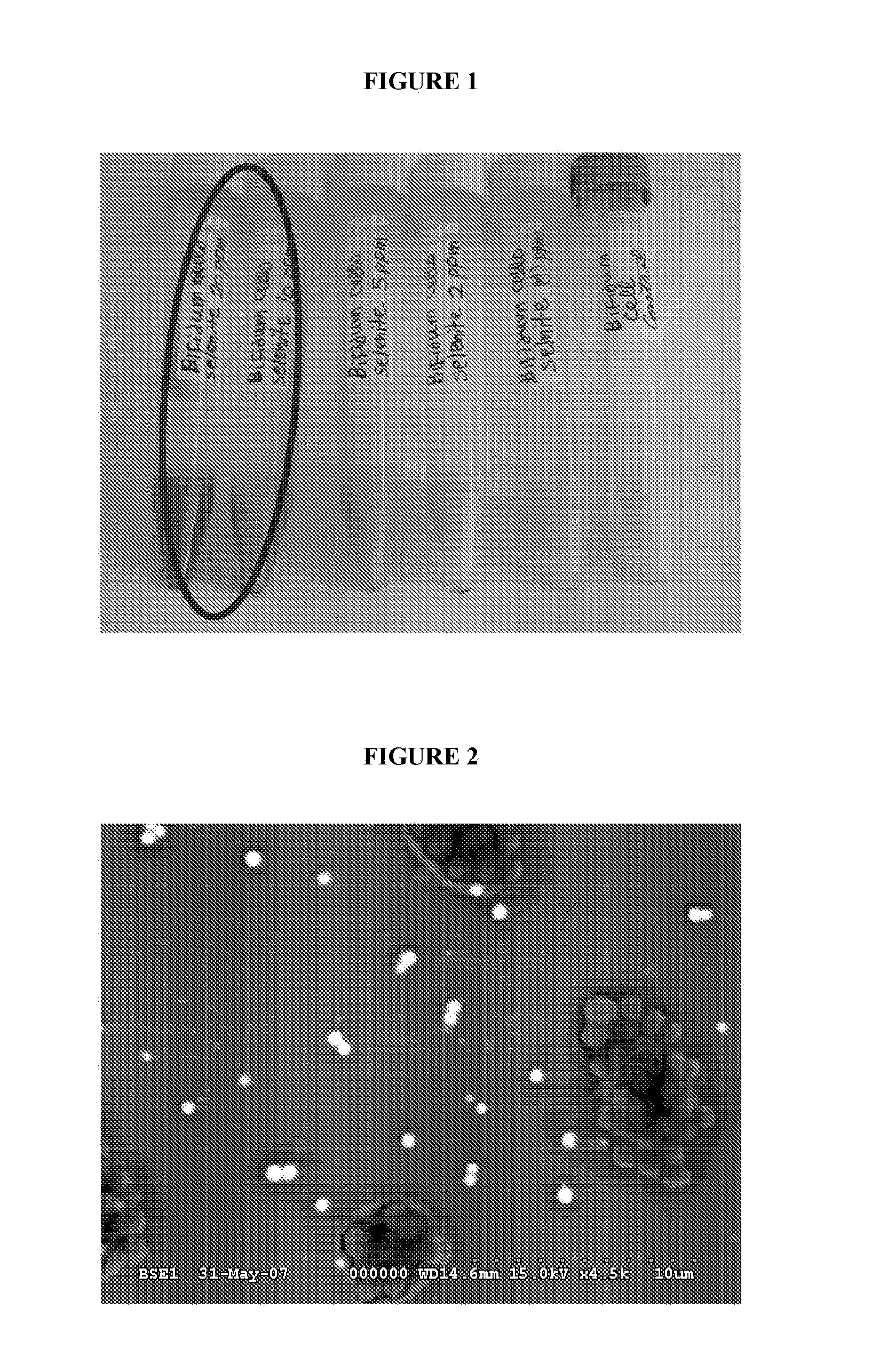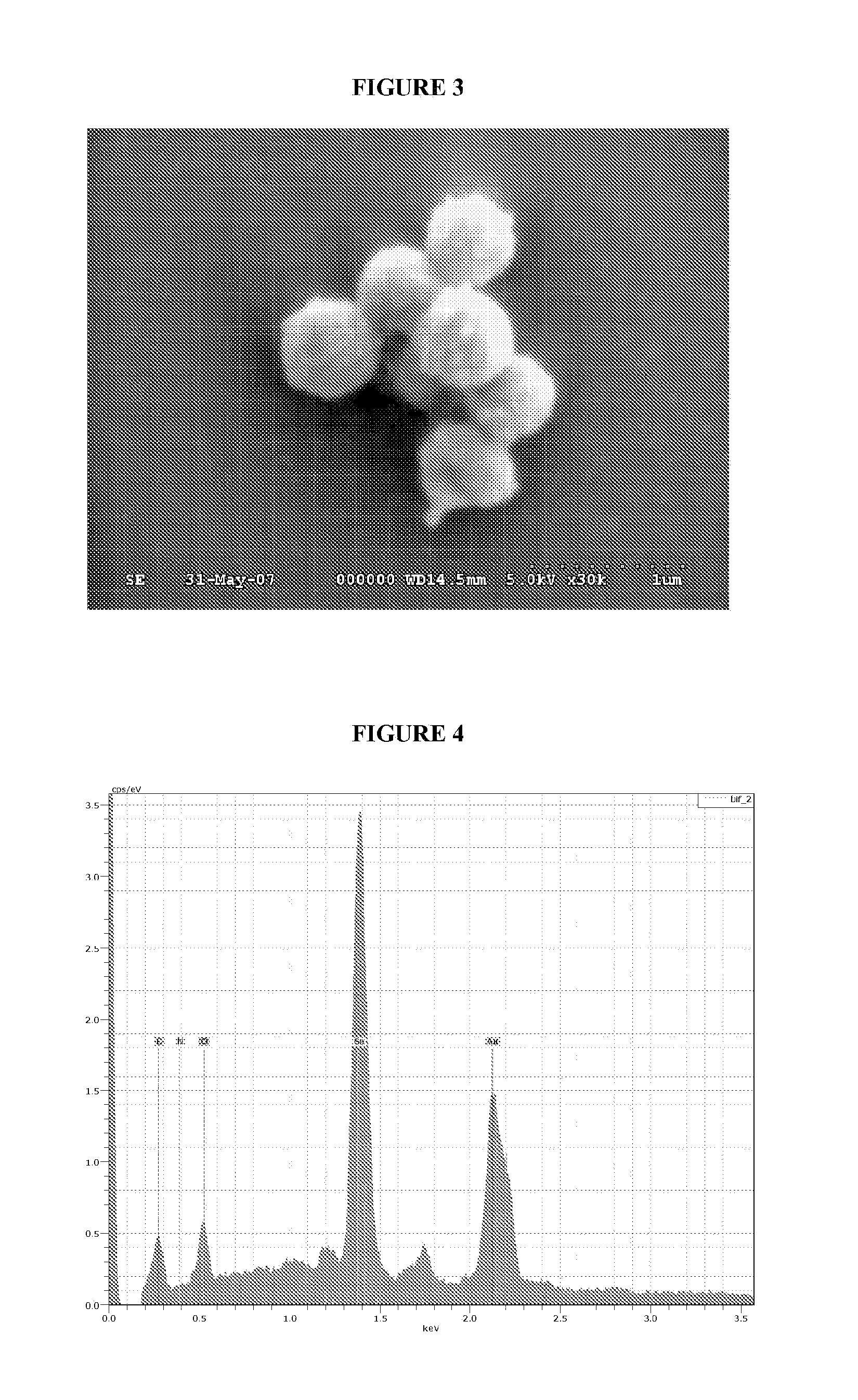Process for producing elemental selenium nanospheres
a technology of elemental selenium and nanospheres, which is applied in the field of microbiological processes, can solve the problems of inability to adapt to the industrial application of the employed organism, no established practice and experience for and no investigation of the industrial application of the analyzed bacteria. to achieve the effect of broadening the range of useful high-quality raw materials available, reducing the price, and good raw materials
- Summary
- Abstract
- Description
- Claims
- Application Information
AI Technical Summary
Benefits of technology
Problems solved by technology
Method used
Image
Examples
example 1
Production of Grey, Crystalline Selenium
[0080]Formulation and Inoculation of the Medium
[0081]Medium: MRS (DeMan, Rogosa and Sharpe, Scharlau Chemie, Barcelona, Spain, De Man, J. C., Rogosa, M. and Sharpe, M. E. (1960). A medium for the cultivation of lactobacilli (J. Appl Bacteriol. 23: 30-35.). By dissolving with heating 52 g material in 1 litre of water a culture broth having the following composition was obtained:
Componentg / LPeptone10.0Meat extract8.00Yeast extract4.00D(+)-Glucose20.0Sodium acetate5.00Triammonium citrate2.00Potassium hydrogen phosphate2.00Magnesium sulphate (MgSO4)0.20Manganase sulphate (MnSO4)0.05Polisorbate 801mlpH 6.2 ± 0.2
[0082]Culture broth was sterilized at 121° C. for 15 minutes.
[0083]Sodium selenite (from 1000 mg / L solution) was added to the broth in an amount resulting in 20 mg / L final concentration of selenium in the broth, namely 20 ml of 1000 mg / L sodium selenite solution was added to 980 ml culture broth.
[0084]Inoculation
[0085]The solution prepared i...
example 2
Preparation of Grey Selenium Via Amorphous Red Selenium Intermediate
[0095]Formulation and Inoculation of the Medium
[0096]Medium used: MRS
[0097]Culture broth was sterilized at 121° C. for 15 minutes, after which sodium selenite (from 1000 mg / L solution) was added to the broth in an amount resulting in 20 mg / L final selenium concentration of the broth, namely 20 ml of 1000 mg / L sodium selenite solution was added to 980 ml culture broth.
[0098]Inoculation
[0099]The solution prepared this way and homogenized by stirring was inoculated with 30 ml of activated Lactobacillus acidophilus strain NCAIM B 02085. For the activation a 3 times activated strain originally being in freeze-dried form was used, which was derived from a strain being deposited at the National Collection of Agricultural and Industrial Microorganisms, Faculty of Food Science, Corvinus University of Budapest (Somlói út 14-16, Budapest, H-1118, Hungary). After activation the absorbance value of the solution was 1.5±0.1 (meas...
example 3
Preparation of Monoclinic Red Selenium
[0102]Formulation and Inoculation of the Medium
[0103]Medium: M17 selective culture broth (Shankar, P. A. and Davies, F. L.: A note on the suppression of Lactobacillus bulgaricus in media containing glycerophosphate and application of the media to selective isolation of Streptococcus thermophilus from yoghurt. J. Soc. Dairy Technol. 30 (1): 28., 1977) for Streptococcus thermophilus. By dissolving 37 g powder in 1 litre of water the following composition was obtained:
Componentg / LTripton2.50Meat peptone2.50Soy peptone5.00Yeast extract2.50Meat extract5.00Sodium glycerophosphate19.0Magnesia sulphate (MgSO4)0.25Ascorbinic acid0.50pH6.5
[0104]Culture broth sterilized at 121° C. for 15 minutes. Sodium selenite (from 1000 mg / L solution) was added to the culture broth in an amount resulting in 20 mg / L final selenium concentration of the broth, namely 20 ml of 1000 mg / L sodium selenite solution was added to 980 ml culture broth.
[0105]Inoculation
[0106]The so...
PUM
 Login to View More
Login to View More Abstract
Description
Claims
Application Information
 Login to View More
Login to View More - R&D
- Intellectual Property
- Life Sciences
- Materials
- Tech Scout
- Unparalleled Data Quality
- Higher Quality Content
- 60% Fewer Hallucinations
Browse by: Latest US Patents, China's latest patents, Technical Efficacy Thesaurus, Application Domain, Technology Topic, Popular Technical Reports.
© 2025 PatSnap. All rights reserved.Legal|Privacy policy|Modern Slavery Act Transparency Statement|Sitemap|About US| Contact US: help@patsnap.com



